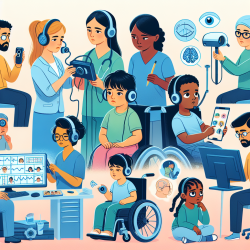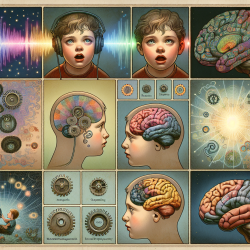Introduction
In the field of speech-language pathology, the diagnosis and treatment of hearing impairments in children are critical for ensuring optimal developmental outcomes. The research article "Evaluating Long-Latency Auditory Evoked Potentials in the Diagnosis of Cortical Hearing Loss in Children" by Lopez-Soto, Postigo-Madueno, and Nunez-Abades provides valuable insights into the use of Long-Latency Auditory Evoked Potentials (LLEPs) for diagnosing cortical hearing loss in children. This blog aims to help practitioners improve their diagnostic skills by implementing the findings of this study or encouraging further research in this area.
Understanding Cortical Hearing Loss
Cortical hearing loss is characterized by the absence of apparent damage to the auditory system, yet the patient experiences hearing difficulties. This condition can often be misdiagnosed due to overlapping symptoms with other disorders such as attention-related or language-based disorders. The study highlights the importance of using LLEPs to identify cases of cortical hearing loss, particularly when traditional audiological tests fail to provide clear results.
The Role of Long-Latency Auditory Evoked Potentials
LLEPs are crucial in assessing the maturity of the central auditory pathways. They are related to attention, memory, and auditory discrimination skills, making them a robust tool for identifying immature cortical processing. The study presented two cases where LLEPs were instrumental in diagnosing cortical hearing loss in children aged 8 and 11, despite normal anatomical findings and traditional audiological tests.
Case Highlights
- Case 1: An 8-year-old boy with suspected hearing loss showed normal results in standard audiological tests but had immature LLEPs, indicating cortical underdevelopment.
- Case 2: An 11-year-old boy with a history of language-based learning disorders also presented normal audiological test results, but LLEPs revealed delayed maturation of the central auditory system.
Implications for Practice
The findings of this study suggest that practitioners should consider incorporating LLEPs into their diagnostic toolkit, especially in cases where traditional methods do not align with clinical observations. By doing so, they can:
- Identify cortical hearing loss early, allowing for timely intervention.
- Differentiate between peripheral and central auditory processing issues.
- Guide appropriate neuropsychological assessments to address related cognitive or attention deficits.
Encouraging Further Research
While the study provides compelling evidence for the use of LLEPs, further research is needed to refine diagnostic criteria and explore the full potential of this method in various clinical settings. Practitioners are encouraged to engage in research initiatives that expand our understanding of cortical hearing loss and its implications for child development.
Conclusion
Incorporating LLEPs into the diagnostic process can significantly enhance the accuracy of identifying cortical hearing loss in children. By leveraging data-driven approaches, speech-language pathologists can improve outcomes for children with auditory processing challenges. For those interested in exploring the detailed findings of the study, the original research paper can be accessed through this link: Evaluating Long-Latency Auditory Evoked Potentials in the Diagnosis of Cortical Hearing Loss in Children.










